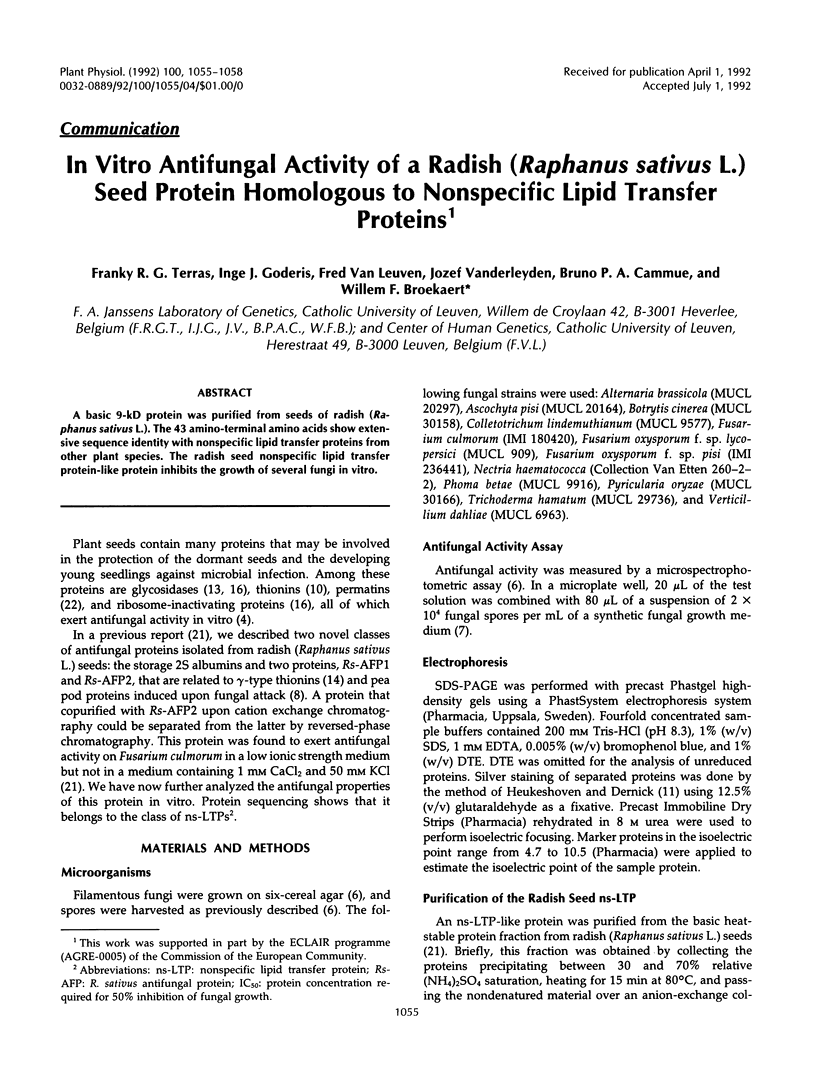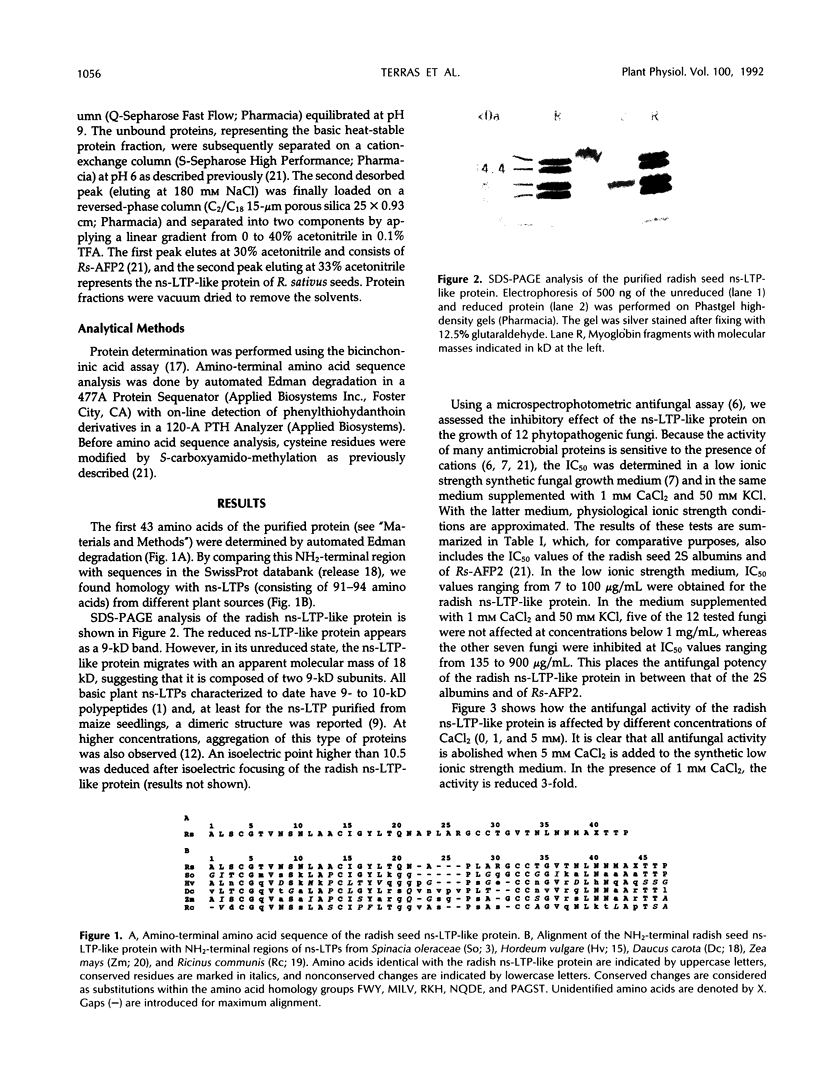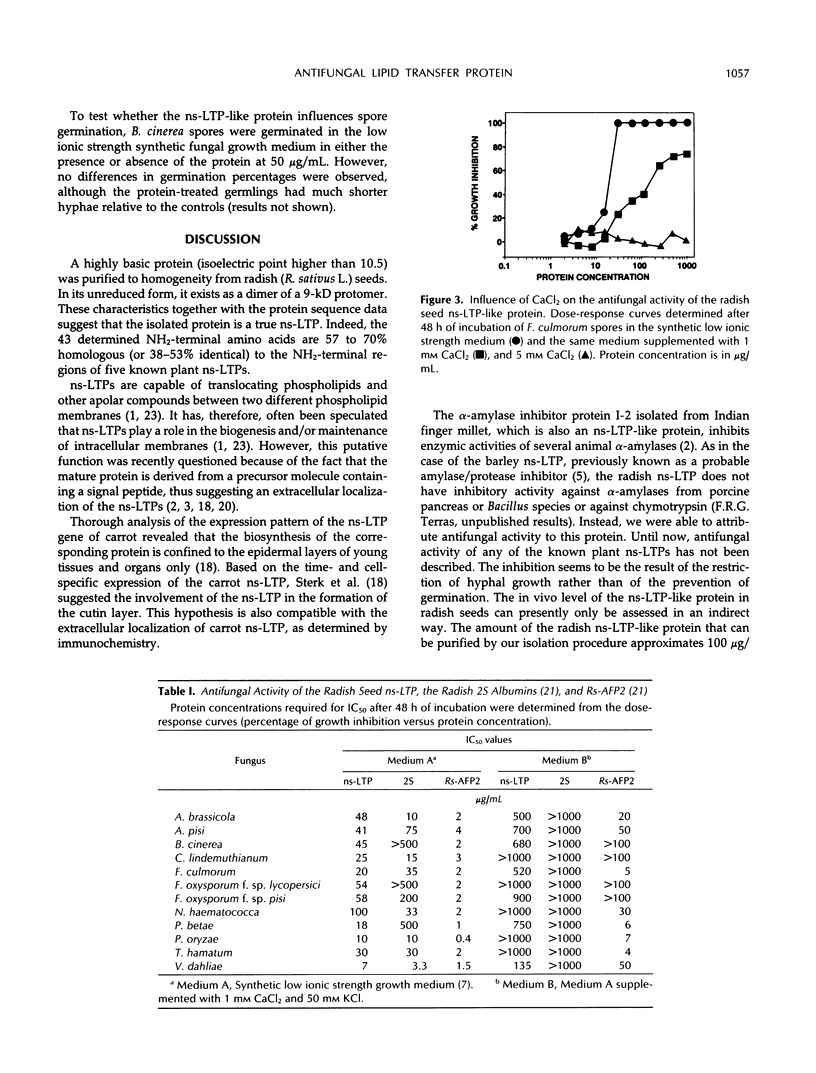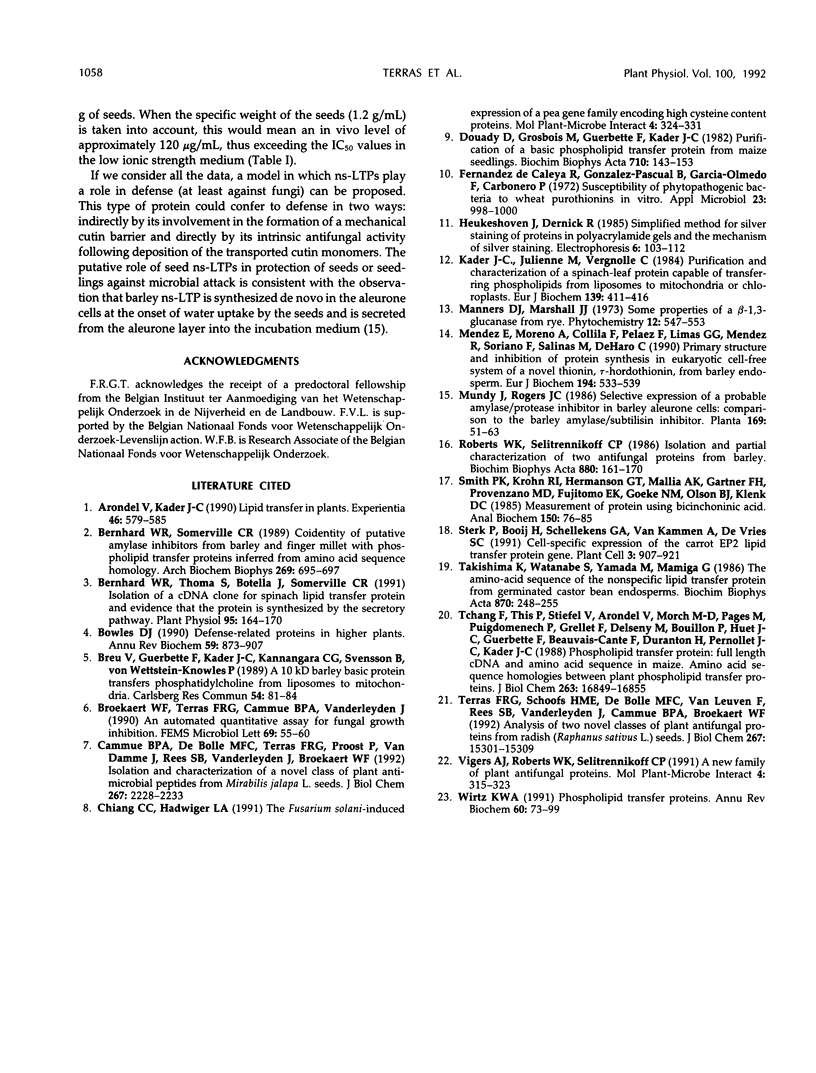Abstract
A basic 9-kD protein was purified from seeds of radish (Raphanus sativus L.). The 43 amino-terminal amino acids show extensive sequence identity with nonspecific lipid transfer proteins from other plant species. The radish seed nonspecific lipid transfer protein-like protein inhibits the growth of several fungi in vitro.
Full text
PDF



Images in this article
Selected References
These references are in PubMed. This may not be the complete list of references from this article.
- Arondel V., Kader J. C. Lipid transfer in plants. Experientia. 1990 Jun 15;46(6):579–585. doi: 10.1007/BF01939696. [DOI] [PubMed] [Google Scholar]
- Bernhard W. R., Somerville C. R. Coidentity of putative amylase inhibitors from barley and finger millet with phospholipid transfer proteins inferred from amino acid sequence homology. Arch Biochem Biophys. 1989 Mar;269(2):695–697. doi: 10.1016/0003-9861(89)90154-9. [DOI] [PubMed] [Google Scholar]
- Bernhard W. R., Thoma S., Botella J., Somerville C. R. Isolation of a cDNA Clone for Spinach Lipid Transfer Protein and Evidence that the Protein Is Synthesized by the Secretory Pathway. Plant Physiol. 1991 Jan;95(1):164–170. doi: 10.1104/pp.95.1.164. [DOI] [PMC free article] [PubMed] [Google Scholar]
- Bowles D. J. Defense-related proteins in higher plants. Annu Rev Biochem. 1990;59:873–907. doi: 10.1146/annurev.bi.59.070190.004301. [DOI] [PubMed] [Google Scholar]
- Cammue B. P., De Bolle M. F., Terras F. R., Proost P., Van Damme J., Rees S. B., Vanderleyden J., Broekaert W. F. Isolation and characterization of a novel class of plant antimicrobial peptides form Mirabilis jalapa L. seeds. J Biol Chem. 1992 Feb 5;267(4):2228–2233. [PubMed] [Google Scholar]
- Chiang C. C., Hadwiger L. A. The Fusarium solani-induced expression of a pea gene family encoding high cysteine content proteins. Mol Plant Microbe Interact. 1991 Jul-Aug;4(4):324–331. doi: 10.1094/mpmi-4-324. [DOI] [PubMed] [Google Scholar]
- Fernandez de Caleya R., Gonzalez-Pascual B., García-Olmedo F., Carbonero P. Susceptibility of phytopathogenic bacteria to wheat purothionins in vitro. Appl Microbiol. 1972 May;23(5):998–1000. doi: 10.1128/am.23.5.998-1000.1972. [DOI] [PMC free article] [PubMed] [Google Scholar]
- Kader J. C., Julienne M., Vergnolle C. Purification and characterization of a spinach-leaf protein capable of transferring phospholipids from liposomes to mitochondria or chloroplasts. Eur J Biochem. 1984 Mar 1;139(2):411–416. doi: 10.1111/j.1432-1033.1984.tb08020.x. [DOI] [PubMed] [Google Scholar]
- Mendez E., Moreno A., Colilla F., Pelaez F., Limas G. G., Mendez R., Soriano F., Salinas M., de Haro C. Primary structure and inhibition of protein synthesis in eukaryotic cell-free system of a novel thionin, gamma-hordothionin, from barley endosperm. Eur J Biochem. 1990 Dec 12;194(2):533–539. doi: 10.1111/j.1432-1033.1990.tb15649.x. [DOI] [PubMed] [Google Scholar]
- Roberts W. K., Selitrennikoff C. P. Isolation and partial characterization of two antifungal proteins from barley. Biochim Biophys Acta. 1986 Feb 19;880(2-3):161–170. doi: 10.1016/0304-4165(86)90076-0. [DOI] [PubMed] [Google Scholar]
- Smith P. K., Krohn R. I., Hermanson G. T., Mallia A. K., Gartner F. H., Provenzano M. D., Fujimoto E. K., Goeke N. M., Olson B. J., Klenk D. C. Measurement of protein using bicinchoninic acid. Anal Biochem. 1985 Oct;150(1):76–85. doi: 10.1016/0003-2697(85)90442-7. [DOI] [PubMed] [Google Scholar]
- Sterk P., Booij H., Schellekens G. A., Van Kammen A., De Vries S. C. Cell-specific expression of the carrot EP2 lipid transfer protein gene. Plant Cell. 1991 Sep;3(9):907–921. doi: 10.1105/tpc.3.9.907. [DOI] [PMC free article] [PubMed] [Google Scholar]
- Tchang F., This P., Stiefel V., Arondel V., Morch M. D., Pages M., Puigdomenech P., Grellet F., Delseny M., Bouillon P. Phospholipid transfer protein: full-length cDNA and amino acid sequence in maize. Amino acid sequence homologies between plant phospholipid transfer proteins. J Biol Chem. 1988 Nov 15;263(32):16849–16855. [PubMed] [Google Scholar]
- Terras F. R., Schoofs H. M., De Bolle M. F., Van Leuven F., Rees S. B., Vanderleyden J., Cammue B. P., Broekaert W. F. Analysis of two novel classes of plant antifungal proteins from radish (Raphanus sativus L.) seeds. J Biol Chem. 1992 Aug 5;267(22):15301–15309. [PubMed] [Google Scholar]
- Vigers A. J., Roberts W. K., Selitrennikoff C. P. A new family of plant antifungal proteins. Mol Plant Microbe Interact. 1991 Jul-Aug;4(4):315–323. doi: 10.1094/mpmi-4-315. [DOI] [PubMed] [Google Scholar]
- Wirtz K. W. Phospholipid transfer proteins. Annu Rev Biochem. 1991;60:73–99. doi: 10.1146/annurev.bi.60.070191.000445. [DOI] [PubMed] [Google Scholar]



